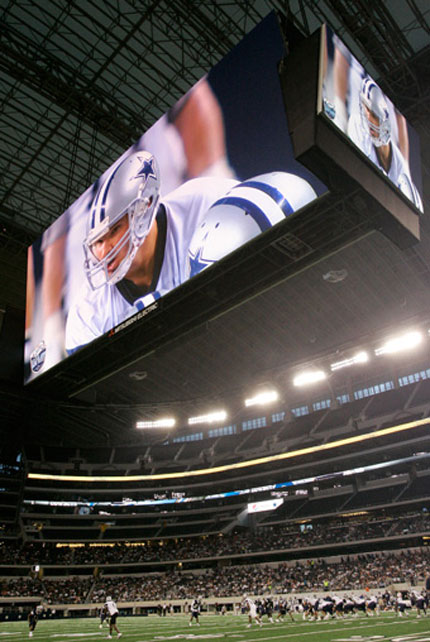 The centerpiece of Cowboys Stadium, Arlington, Texas. Photo by AP Photo/Tony Gutierrez
The centerpiece of Cowboys Stadium, Arlington, Texas. Photo by AP Photo/Tony GutierrezThere are many exciting moments in your typical NFL game. A running back, disregarding all self-preservational instinct, leaps headfirst over a pile of linemen and lands in the end zone. A linebacker nearly decapitates some rail-thin wide receiver flashing across the middle. Cheerleaders return from halftime wearing new outfits. A punt, however, does not generally quicken one’s pulse. Punts are the prelude to a commercial break, a moment to pause and consider that next beer, or to wonder if it’s worth bathing today.
So when A.J. Trapasso, the Tennessee Titans’ backup punter, stepped onto the field during a sleepy preseason game in Dallas this August, it’s likely that nobody was expecting anything out of the ordinary. In fact, there were probably very few eyes on Trapasso when the football boomed off his foot. That’s because Trapasso was kicking in the Dallas Cowboys’ bombastic new $1.2 billion stadium, an ultra-opulent temple built to honor owner Jerry Jones’s great loves — football, the Cowboys, and conspicuous consumption. The fans in attendance were probably looking at anything besides the punt — the “world’s largest operable glass doors,” for instance, which can be found at the far end of the stadium, and through which the entire field slides on a set of tracks when non-football events are held at the stadium.
Even more likely, they were gawking at a very, very large scoreboard — the 160-foot-long, 1.2 million pound, Mitsubishi Diamond Vision true HD display, that is the centerpiece of Cowboys Stadium. This is a spectacular object, this scoreboard. It cost, by itself, twice as much to build as the previous Cowboys Stadium. It is maintained via a ten-level internal scaffolding system and its use requires the services of a full-time, highly trained operations team. Its display capacity is equal to 4,920 52-inch flat panel televisions, and it is illuminated by 30 million pulsing light bulbs. In short, it makes your typical Jumbotron look like a 13-inch TV/VCR.
But the devil, as they say, is in the details. As Trapasso’s otherwise ordinary kick neared its apex, the ball ricocheted off the bottom of the screen and dropped to the turf like a duck shot from the sky. That was not supposed to happen.
Someone hung the damn scoreboard too low.
Confusion took hold that evening in Dallas. Titans coach Jeff Fisher challenged the play, claiming interference, and the referees kind of shrugged their shoulders, not exactly sure how to proceed. You see, there is little precedent for such events in the NFL rulebook, mostly because no team had ever constructed a scoreboard the size of Rhode Island.
How, you might ask, could such a colossal oversight come to pass? How could someone install a $40 million scoreboard and not take into consideration the fact that games are played beneath it? Was it hubris? Incompetence? An honest mistake? These questions are irrelevant. The NFL ruled afterwards that the Cowboys do not have to raise the scoreboard until the season has ended. For this one season, games played in Dallas will be some weird mashup of football and pinball. And believe it or not, this is a good thing.
To understand why, you must understand the spirit of the NFL, which is cold and steely, like a refrigerator door. In the NFL, unregimented behavior, peculiar attitudes — these things are frowned upon. Players wearing the wrong-colored cleats are fined heavily. Acts of self-expression are strongly discouraged: in order for Bengals wide receiver Chad “Ochocinco” Johnson to wear his nickname on the back of his jersey, he was forced to legally change his last name to…Ochocinco. Unlike baseball, with its pastoral traditions and idiosyncratic ballparks, professional football is a game of stark uniformity. This is manifested most significantly in the design of NFL stadiums. Giants Stadium, the Superdome, the old Astrodome, and even the newer stadiums in Philadelphia and Baltimore — all massive, soulless, interchangeable bowls, possessing no distinct visual identity. Of course, this is no accident. Football, America’s great and mighty game, is played in these stadiums. If you want bells and whistles, go ride a Schwinn.
But now…now there is this massive, wonderful, ill-conceived scoreboard in Dallas, looming over the field like the Death Star, deflecting punts and infuriating coaches and giving you, the viewer at home, something new and innocuous to get excited about. “Look at that stupid thing,” you’ll say. “It’s too damn big! Those guys in Dallas, they’re idiots.”
But you won’t be changing the channel during a punt.
